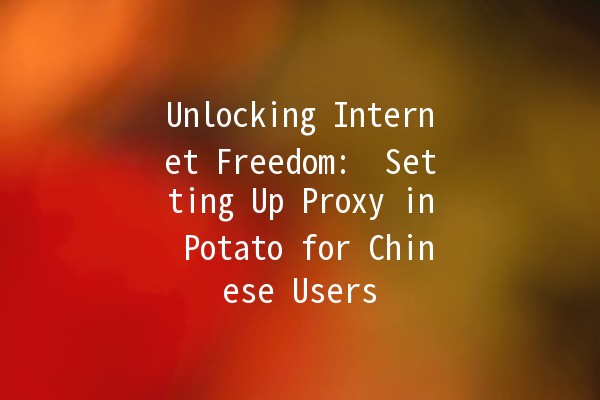In an era where internet freedom is not just a luxury but a necessity, having the option to set up proxies on applications such as Potato is invaluable. Whether you need to bypass georestrictions, maintain anonymity while browsing, or ensure a stable internet connection, setting up a proxy can significantly enhance your online experience.
Understanding Potato and Proxy Servers
What is Potato?
Potato is a popular application used by many internet users, particularly in China, as they navigate a web replete with restrictions. Potato helps users manage their network connections more effectively, allowing for seamless browsing and content access.
What is a Proxy Server?
A proxy server acts as an intermediary between your device and the internet. When you use a proxy, your requests to access websites are sent to the proxy first, which then forwards them to the website. The website responds back to the proxy, which in turn sends the data back to you. This process offers various advantages, such as:
Anonymity: Your actual IP address is concealed, making it challenging for websites to track your location.
Bypassing Restrictions: Access content that may be blocked in certain regions.

Enhanced Security: Proxies can offer additional layers of encryption.
Setting Up Proxy in Potato: Practical Tips
Now that we understand the importance of proxies, let’s delve into the practical side of setting up proxies within the Potato application.
Different types of proxies serve different purposes. When using Potato, it’s essential to select the right type of proxy based on your requirements:
HTTP Proxies: Best for web browsing, HTTP proxies are widely used due to their compatibility with browsers and lightweight nature.
SOCKS Proxies: More versatile than HTTP proxies, SOCKS proxies can handle a variety of traffic, including email and FTP.
Transparent Proxies: These do not hide your IP address but are often used in organizational settings for content filtering.
Example: If your goal is to access regionrestricted streaming services, consider using an HTTP proxy that specializes in bypassing geographic restrictions.
Before setting up your proxy in Potato, you’ll need the relevant information from a proxy provider. This includes:
Proxy IP address
Port number
Authentication credentials (username and password, if necessary)
Example: A common proxy might look like this: `192.168.1.1:8080`, where `192.168.1.1` is the IP address, and `8080` is the port number.
Now that you have the necessary information, it’s time to set up the proxy in Potato:
Example: Navigate to `Settings > Network > Proxy`, and enter the `192.168.1.1` in the address field and `8080` in the port field.
After configuring, it’s crucial to test whether the proxy is functioning correctly:
Check IP Address: Use online tools to verify your IP address before and after setting up the proxy.
Access Restricted Content: Try to access websites that were previously blocked. If you can access them, the proxy is working correctly.
Example Tool: Use websites like “whatismyipaddress.com” to see if your IP has changed after the proxy setup.
Setting up a proxy might not always go smoothly. Here are a few common issues and their solutions:
Connection Errors: Ensure that the proxy IP and port number are entered correctly. Doublecheck your internet connection as well.
Slow Speeds: If the proxy is slow, consider using a different server or switching to a more reliable proxy provider.
Example: If your connection feels sluggish, try another proxy IP or check if the original IP is overloaded with user traffic.
Once your proxy is set up and running, there are additional steps you can take to maximize its effectiveness:
Use a VPN: For an added layer of security and to mask your online activities further, consider pairing your proxy with a VPN service.
Regularly Update Proxy Information: Proxy servers can go offline or become less effective over time, so it’s wise to stay updated with your provider for the best addresses.
Practical Tip: Keep a list of fast and reliable proxy IPs from trusted sources for quick reference.
Frequently Asked Questions
A proxy serves as an intermediary for web requests, while a VPN encrypts your entire internet connection and hides your IP address. VPNs provide greater overall security compared to proxies.
Yes, you can use free proxies, but they often come with risks like slower speeds and less reliability. Always be cautious and consider using paid services for better security and speed.
Common reasons include incorrect configuration details, server downtime, or your internet connection being unstable. Ensure everything is correctly set up, and try different parameters if necessary.
Setting up a proxy is generally legal, but using it to engage in illegal activities is not. Always respect the laws and regulations of your region when using proxies.
If you notice slow speeds or access issues, it might be time to switch proxies. For general security and privacy, changing proxies regularly can help prevent tracking.
Key aspects include reliability, speed, level of anonymity, and customer support. Reading reviews and comparing various providers can help you find the best fit for your needs.
Setting up a proxy in the Potato application can greatly enhance your online experience, especially in regions like China where internet access can be restrictive. By following these practical tips and ensuring you're using reliable proxy services, you can browse the web with increased freedom and security. Remember to stay safe and informed while exploring the vast resources available online.